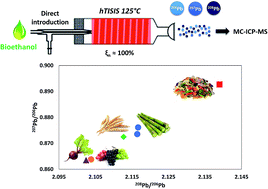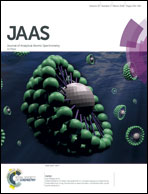Direct lead isotopic analysis of bioethanol by means of multi-collector ICP-mass spectrometry with a total consumption sample introduction system
Abstract
A method has been developed for the direct (no sample pre-treatment and/or isolation of the target analyte from the sample matrix) lead isotopic analysis of bioethanol samples via multi-collector inductively coupled plasma-mass spectrometry (MC-ICP-MS). A total consumption sample introduction system, the so-called high-temperature Torch-Integrated Sample Introduction System (hTISIS), equipped with a PFA micro-nebulizer and a heated small-volume spray chamber, has been used for (i) reducing the analyte concentration required for obtaining accurate and precise lead isotope ratio results and (ii) mitigating the effect of the ethanol–water ratio on the extent of mass bias. The results obtained when using the hTISIS have been compared to those obtained with a more conventional sample introduction system, i.e., a micro-nebulizer mounted onto a cyclonic spray chamber at room temperature. The performance of both introduction systems has been assessed for two different plasma interfaces. The Pt standard sampling cone has been combined with an X-type or H-type skimmer cone, respectively. The sensitivity achieved with the hTISIS was between 3- and 7.5-fold higher, depending on the ethanol–water ratio, than that with the conventional sample introduction system, thus permitting accurate lead isotope ratios to be obtained at lower concentration levels without degradation of the precision. The external precisions, reported as twice the relative standard deviation (2RSD), for 207Pb/206Pb and 208Pb/206Pb were 0.007% and 0.008%, respectively, whereas the internal precision was 0.007% (2RSD) for both isotope ratios. The effects of ethanol content and the hTISIS temperature on the extent of mass bias have been evaluated for the four instrument setups (different sample introduction system/skimmer cone type combinations). The combination of (i) internal correction using NIST SRM 997 – thallium as an internal standard relying on Russell's law and (ii) external correction using NIST SRM 981 – lead, prepared in 75% ethanol, in a sample-standard bracketing (SSB) approach was used for mass bias correction. Although bioethanol samples may contain different amounts of water, the correction described above enabled adequate correction for mass bias in ethanol–water matrices with a water content of 0–40% and thus, also for actual bioethanol samples, when using the hTISIS operated at 125 °C and an X-type skimmer cone. The methodology has been successfully validated by means of lead isotopic analysis of bioethanol samples spiked with a lead standard previously characterized isotopically. Finally, as a proof of concept, actual bioethanol samples have been analyzed and significant differences in the lead isotope ratios have been observed.

- This article is part of the themed collections: JAAS Emerging Investigator Lectureship winners and JAAS Recent HOT articles


 Please wait while we load your content...
Please wait while we load your content...